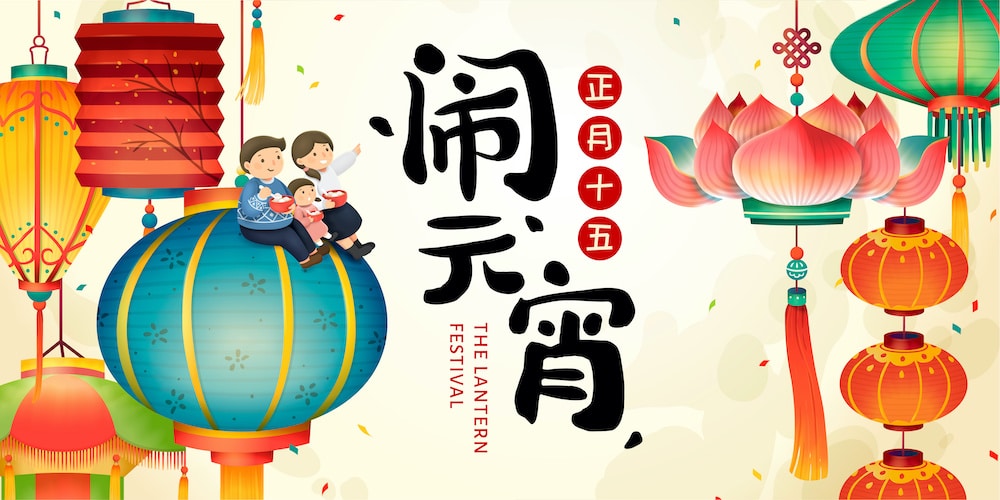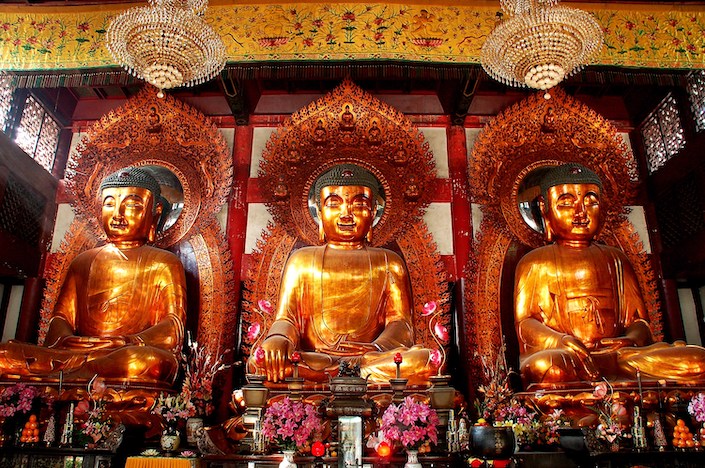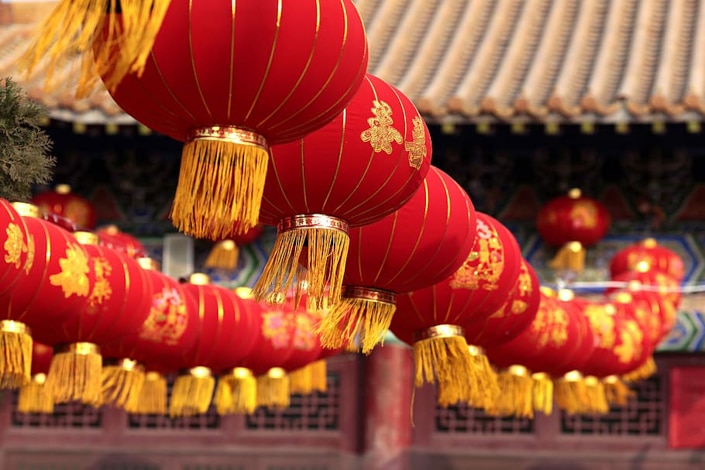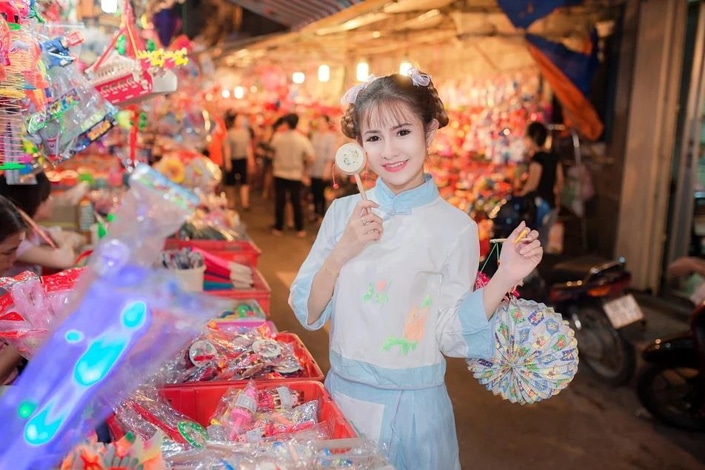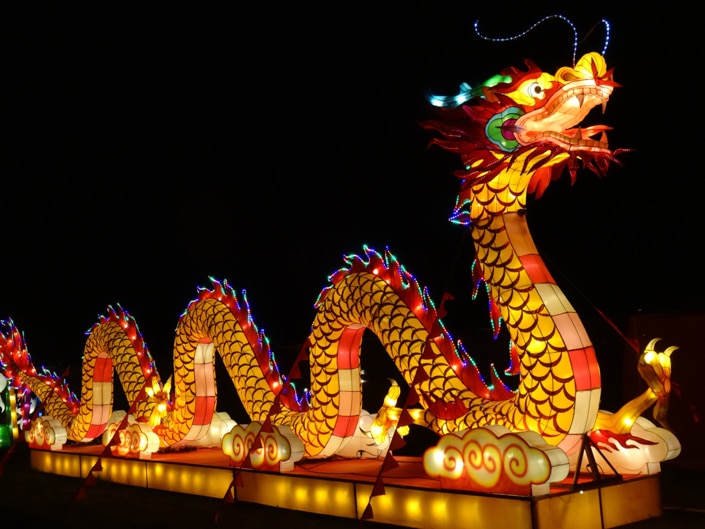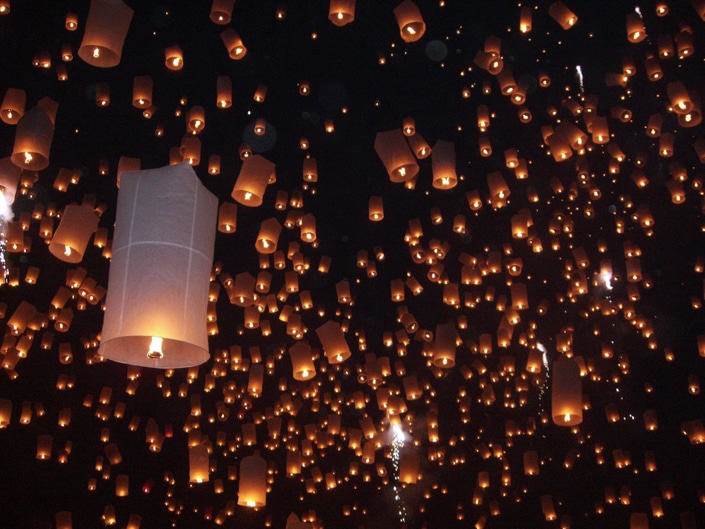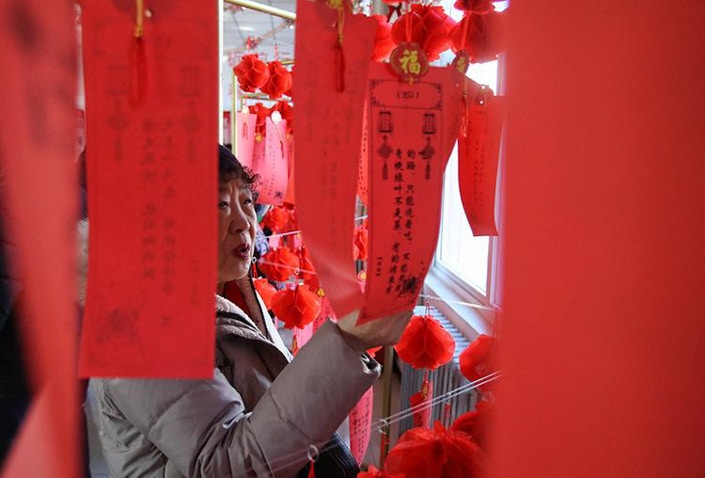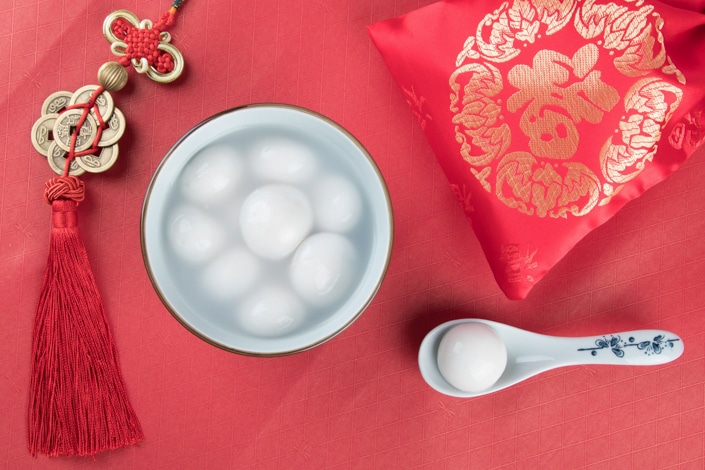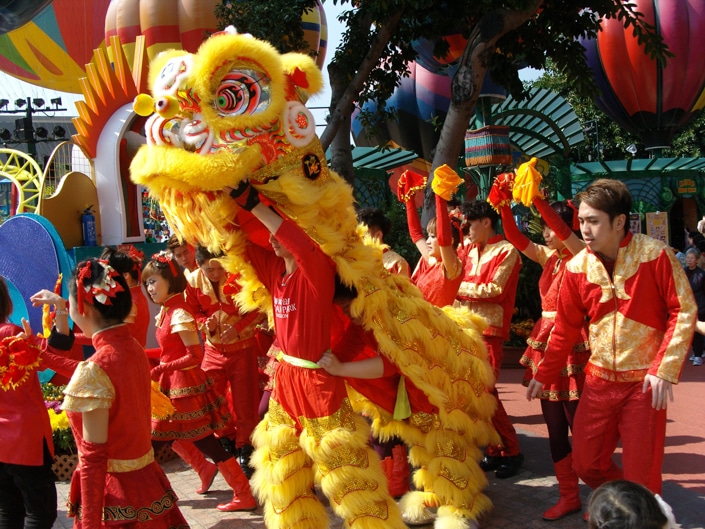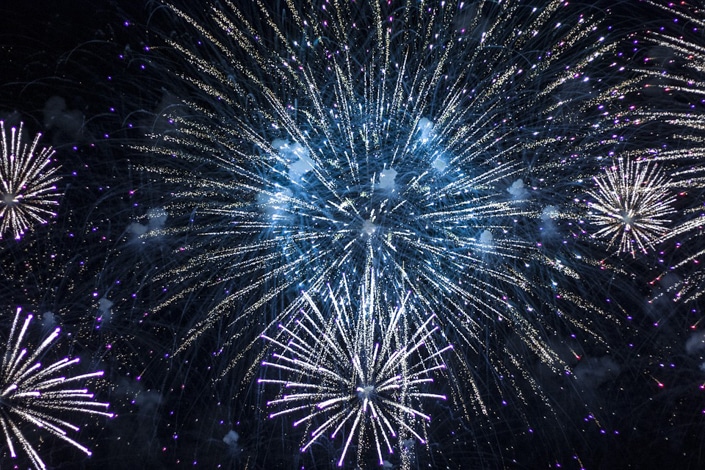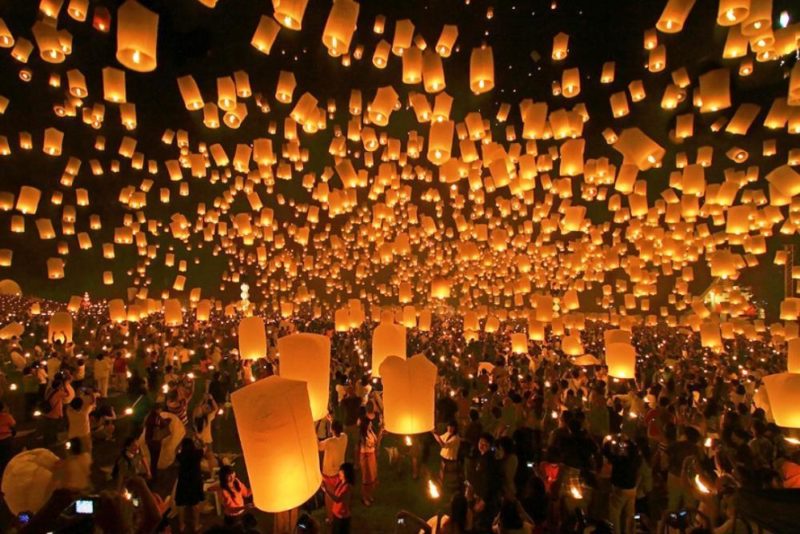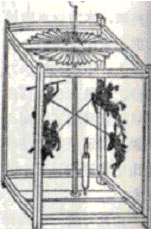Праздник Фонарей – Юаньсяо цзе (元宵节)
Не успеет закончиться праздник Нового года, как весь Китай в ночь на 15-е число первой луны (в феврале-марте) празднует другой, не менее веселый и яркий «праздник фонарей» (灯节 Дэн Цзе). Иногда этот праздник еще именуют «первый ночной праздник» (元宵节 Юаньсяо цзе) и «праздник в честь первого полнолуния» (Шанюань цзе).
Праздник фонарей любим китайским народом еще с древности. Как видно из самого названия, главное занятие в день праздника – это любования красотой фонарей различных форм и размеров. Этот обычай восходит к первому веку. Император Минди из династии Хань был сторонником буддизма. Узнав, что у монахов существует традиция медитировать на мощи Будды 15 числа первого месяца и в знак почтения к основателю учения зажигать фонари, император приказал в этот день вечером зажигать фонари у себя во дворце и храмах в знак уважения к Будде. Впоследствии этот ритуальный буддийский праздник полюбился простому народу, постепенно стал торжественным народным праздником и распространился по всему Китаю.
Еще одним любимым развлечением в этот день является разгадывание загадок на фонарях. Хозяин фонаря обычно вешает загадку на дно фонаря, чтобы можно было сорвать бумажку, если знаешь ответ. Эти загадки интересны тем, что содержат в себе многовековую народную мудрость Китая.
Днем во многих местах устраиваются различные фольклорные представления: танец с фонарями в виде огненного дракона, танец львов, представления на ходулях. А вечером принято кушать “юаньсяо” – своего рода круглые галушки из рисовой муки с разнообразной начинкой. Юаньсяо так называется, т.к. его едят ночью (сяо), когда луна в первый раз в новом году бывает круглой (юань). Существует поверье, что вместе отведав “юаньсяо” вся семья будет жить счастливо.
StudyChinese.ru
From Wikipedia, the free encyclopedia
This article is about the Lantern Festival in China. For the Lantern Festival in Korea, see Yeondeunghoe.
This article is about the Lantern Festival in China. For related festivals in the East Asian cultural sphere, see First Full Moon Festival.
| Lantern Festival 元宵節 元宵节 |
|
|---|---|

Lantern Festival celebrated in Tainan at night |
|
| Official name | Yuánxiāo jié (元宵節) / Shàngyuán jié (上元節) |
| Observed by | Chinese |
| Type | Cultural |
| Significance | Marks the end of the Chinese New Year |
| Observances | Flying of paper lanterns; Consumption of tangyuan |
| Date | 15th day of the 1st month (lunisolar year) |
| 2023 date | 5 February |
| 2024 date | 14 February |
| Related to | Chotrul Duchen (in Tibet) Daeboreum (in Korea) Koshōgatsu (in Japan) Magha Puja (in Thailand, Sri Lanka, Myanmar, Cambodia and Laos) Tết Nguyên Tiêu (in Vietnam) |
| Lantern Festival | ||||||||||||||||||||||||||
|---|---|---|---|---|---|---|---|---|---|---|---|---|---|---|---|---|---|---|---|---|---|---|---|---|---|---|
| Traditional Chinese | 元宵節 | |||||||||||||||||||||||||
| Simplified Chinese | 元宵节 | |||||||||||||||||||||||||
| Literal meaning | «Prime Night Festival» | |||||||||||||||||||||||||
|
||||||||||||||||||||||||||
| Hokkien Name | ||||||||||||||||||||||||||
| Traditional Chinese | 十五暝 / 上元 | |||||||||||||||||||||||||
| Literal meaning | «15th Night» / «Top Primary» | |||||||||||||||||||||||||
|
Statues of mother and daughter celebrating the Lantern Festival. Xi’an
The Lantern Festival (traditional Chinese: 元宵節; simplified Chinese: 元宵节; pinyin: Yuánxiāo jié), also called Shangyuan Festival (traditional Chinese: 上元節; simplified Chinese: 上元节; pinyin: Shàngyuán jié), is a Chinese traditional festival celebrated on the fifteenth day of the first month in the lunisolar Chinese calendar, during the full moon. Usually falling in February or early March on the Gregorian calendar, it marks the final day of the traditional Chinese New Year celebrations.[1] As early as the Western Han Dynasty (206 BC–AD 25), it had become a festival with great significance.[2]
During the Lantern Festival, children go out at night carrying paper lanterns and solve riddles on the lanterns (traditional Chinese: 猜燈謎; simplified Chinese: 猜灯谜; pinyin: cāidēngmí).[3][4] In ancient times, the lanterns were fairly simple, and only the emperor and noblemen had large ornate ones.[5] In modern times, lanterns have been embellished with many complex designs.[4] For example, lanterns are now often made in the shape of animals. The lanterns can symbolize the people letting go of their past selves and getting new ones,[6] which they will let go of the next year. The lanterns are almost always red to symbolize good fortune.[7]
The festival acts as an Uposatha day on the Chinese calendar.[8][9] It should not be confused with the Mid-Autumn Festival; which is sometimes also known as the «Lantern Festival» in locations such as Indonesia, Malaysia, and Singapore.[2][10] Lantern Festivals have also become popular in Western countries, such as the Water Lantern Festival held in multiple locations in the United States.[11] In London, the Magical Lantern Festival is held annually.[12]
Origin[edit]
There are several beliefs about the origin of the Lantern Festival. However, its roots trace back more than 2,000 years ago and is popularly linked to the reign of Emperor Ming of the Han dynasty at the time when Buddhism was growing in China.[citation needed] Emperor Ming, an advocate of Buddhism, noticed Buddhist monks would light lanterns in temples on the fifteenth day of the first lunar month. As a result, he ordered all households, temples and the imperial palace to light lanterns on that evening.[13] From there it developed into a folk custom. Another likely origin is the celebration of «the declining darkness of winter» and community’s ability to «move about at night with human-made light,» namely, lanterns. During the Han dynasty, the festival was connected to Ti Yin, the deity of the North Star.[1]
Red lanterns, often seen during the festivities in China
There is one legend that states that it was a time to worship Taiyi, the God of Heaven in ancient times. The belief was that Taiyi controlled the destiny of the human world. He had sixteen dragons at his beck and call and he decided when to inflict drought, storms, famine or pestilence upon human beings. Beginning with Qin Shi Huang, the first emperor of China, all the emperors ordered splendid ceremonies each year. The emperor would ask Taiyi to bring favorable weather and good health to him and his people.[14][5]
Emperor Wu of the Han dynasty directed special attention to this event. In 104 BC, he proclaimed it to be one of the most important celebrations and the ceremony would last throughout the night.
Another legend associates the Lantern Festival with Taoism. Tianguan is the Taoist deity responsible for good fortune. His birthday falls on the fifteenth day of the first lunar month. It is said that Tianguan likes all types of entertainment, so followers prepare various kinds of activities during which they pray for good fortune.[15]
Another legend associates with the Lantern Festival with an ancient warrior named Lan Moon, who led a rebellion against the tyrannical king in ancient China. He was killed in the storming of the city and the successful rebels commemorated the festival in his name.[15]
Yet another common legend dealing with the origins of the Lantern Festival speaks of a beautiful crane that flew down to earth from heaven. After it landed on earth it was hunted and killed by some villagers. This angered the Jade Emperor in heaven because the crane was his favorite. So, he planned a storm of fire to destroy the village on the fifteenth lunar day. The Jade Emperor’s daughter warned the inhabitants of her father’s plan to destroy their village. The village was in turmoil because nobody knew how they could escape their imminent destruction. However, a wise man from another village suggested that every family should hang red lanterns around their houses, set up bonfires on the streets, and explode firecrackers on the fourteenth, fifteenth, and sixteenth lunar days. This would give the village the appearance of being on fire to the Jade Emperor. On the fifteenth lunar day, troops sent down from heaven whose mission was to destroy the village saw that the village was already ablaze, and returned to heaven to report to the Jade Emperor. Satisfied, the Jade Emperor decided not to burn down the village. From that day on, people celebrate the anniversary on the fifteenth lunar day every year by carrying lanterns on the streets and exploding firecrackers and fireworks.[16]
Another legend about the origins of Lantern Festival involves a maid named Yuan-Xiao. In the Han dynasty, Dongfang Shuo was a favorite adviser of the emperor. One winter day, he went to the garden and heard a little girl crying and getting ready to jump into a well to commit suicide. Shuo stopped her and asked why. She said she was Yuan-Xiao, a maid in the emperor’s palace and that she never had a chance to see her family since she started working there. If she could not have the chance to show her filial piety in this life, she would rather die. Shuo promised to find a way to reunite her with her family. Shuo left the palace and set up a fortune-telling stall on the street. Due to his reputation, many people asked for their fortunes to be told but everyone got the same prediction — a calamitous fire on the fifteenth lunar day. The rumor spread quickly.[15]
Everyone was worried about the future so they asked Dongfang Shuo for help. Dongfang Shuo said that on the thirteenth lunar day, the God of Fire would send a fairy in red riding a black horse to burn down the city. When people saw the fairy they should ask for her mercy. On that day, Yuan-Xiao pretended to be the red fairy. When people asked for her help, she said that she had a copy of a decree from the God of Fire that should be taken to the emperor. After she left, people went to the palace to show the emperor the decree which stated that the capital city would burn down on the fifteenth. When the emperor asked Dongfang Shuo for advice, the latter said that the God of Fire liked to eat tangyuan (sweet dumplings). Yuan-Xiao should cook tangyuan on the fifteenth lunar day and the emperor should order every house to prepare tangyuan to worship the God of Fire at the same time. Also, every house in the city should hang red lantern and explode fire crackers. Lastly, everyone in the palace and people outside the city should carry their lanterns on the street to watch the lantern decorations and fireworks. The Jade Emperor would be deceived and everyone would avoid the disastrous fire.[16]
The emperor happily followed the plan. Lanterns were everywhere in the capital city on the night of the fifteenth lunar day and people were walking on the street and there were noisy firecrackers. It looked as if the entire city was on fire. Yuan-Xiao’s parents went into the palace to watch the lantern decorations and were reunited with their daughter. The emperor decreed that people should do the same thing every year. Since Yuan-Xiao cooked the best tangyuan, people called the day Yuan-Xiao Festival.
For each Festival celebrated, a switch in the Chinese Zodiac takes place. If this year is the year of the tiger, next year will be the year of the rabbit(water rabbit) and so on.
Tradition[edit]
Finding love[edit]
In the early days, young people were chaperoned in the streets in hopes of finding love. Matchmakers acted busily in hopes of pairing couples. The brightest lanterns were symbolic of good luck and hope. As time has passed, the festival no longer has such implications in most of Mainland China, Taiwan, or Hong Kong.[10]
Tangyuan or Yuanxiao[edit]
Eaten during the Lantern Festival, tangyuan ‘湯圓’ (Southern China, Taiwan and Southeast Asia) or yuanxiao ‘元宵’ (Northern China) is a glutinous rice ball typically filled with sweet red bean paste, sesame paste, or peanut butter.[3] Actually, tangyuan is different from yuanxiao due to different manual making and filling processes.[17] It can be boiled, fried or steamed, each has independent taste. However, they are very similar in shape and taste, so most people do not distinguish them for convenience and consider them as the same thing.[17] Chinese people believe that the round shape of the balls and the bowls in which they are served symbolize family togetherness, and that eating tangyuan or yuanxiao may bring the family harmony, happiness and luck in the new year.[2][4]
-
Yuanxiao and its fillings
-
Yuanxiao
-
Yuanxiao
-
Yuanxiao
-
Yuanxiao
-
Tangyuan
-
Tangyuan
-
Tangyuan
-
Tangyuan
-
Tang Yuan
6th century and afterwards[edit]
Until the Sui dynasty in the sixth century, Emperor Yang invited envoys from other countries to China to see the colourful lighted lanterns and enjoy the gala performances.[18]
By the beginning of the Tang dynasty in the seventh century, the lantern displays would last three days. The emperor also lifted the curfew, allowing the people to enjoy the festive lanterns day and night. It is not difficult to find Chinese poems which describe this happy scene.[18]
In the Song dynasty, the festival was celebrated for five days and the activities began to spread to many of the big cities in China. Colorful glass and even jade were used to make lanterns, with figures from folk tales painted on the lanterns.[citation needed]
However, the largest Lantern Festival celebration took place in the early part of the 15th century. The festivities continued for ten days. The Yongle Emperor had the downtown area set aside as a center for displaying the lanterns. Even today, there is a place in Beijing called Dengshikou. In Chinese, deng means lantern and shi is market. The area became a market where lanterns were sold during the day. In the evening, the local people would go there to see the beautiful lighted lanterns on display.[citation needed]
Today, the displaying of lanterns is still a major event on the fifteenth day of the first lunar month throughout China. Chengdu in southwest China’s Sichuan Province, for example, holds a lantern fair each year in Culture Park. During the Lantern Festival, the park is a virtual ocean of lanterns. Many new designs attract large numbers of visitors. The most eye-catching lantern is the Dragon Pole. This is a lantern in the shape of a golden dragon, spiraling up a 38-meter-high pole, spewing fireworks from its mouth. Cities such as Hangzhou and Shanghai have adopted electric and neon lanterns, which can often be seen beside their traditional paper or wooden counterparts. Another popular activity at this festival is guessing lantern riddles (which became part of the festival during the Tang dynasty).[19] These often contain messages of good fortune, family reunion, abundant harvest, prosperity and love.[citation needed] Just like the pumpkin carved into jack-o’-lantern for Halloween in the western world, Asian parents sometime teach their children to carve empty the inner tubing of Oriental radish /mooli/ daikon into a Cai-Tou-Lantern (traditional Chinese: 營菜頭燈; simplified Chinese: 营菜头灯; pinyin: yíng cai tóu dēng) for the Festival.[citation needed]
Festivities[edit]
This painting, by an imperial court painter in 1485, depicts the Chenghua Emperor enjoying the festivities with families in the Forbidden City during the traditional Chinese Lantern Festival. It includes acrobatic performances, operas, magic shows and setting off firecrackers.
Lion dance (舞獅), walk on stilts (踩高蹺), riddle games (猜燈謎), dragon dances (耍龍燈) are very popular activities during the festival day and the days following.
The lantern riddle, according to Japanese scholars, became popular as early as the Northern Song Dynasty (960-1126). The lantern riddles are done by a host blocking one side of the lantern and pasting riddles on the remaining three sides of the lanterns. Participants will guess the blocked side by solving the riddles, which is called «breaking/solving lantern riddles». The theme of riddles can be drawn from classics, biographies, poetry, the various philosophers’ well-known stories and novels, proverbs, (the names of) all kinds of birds, animals, and insects, as well as flowers, grasses, vegetables, and herbs. Participants can tear off the riddle of the lantern and let the host verify their answers. Those who answer the correct answer can get a «riddle reward», including ink, paper, writing brushes, ink slabs, fans, perfumed sachets, fruit, or eatables.
[20]
See also[edit]
- Sagichō Fire Festival, the Japanese (Shintoist) festival held in January
- Bon Festival, the Japanese Buddhist Festival held in August
- Festival of Lights (disambiguation), a list of various festivals associated with light
References[edit]
- ^ a b Melton, J. Gordon (2011). «Lantern Festival (China)». In Melton, J. Gordon (ed.). Religious Celebrations: An Encyclopedia of Holidays, Festivals, Solemn Observances, and Spiritual Commemorations. ABC-CLIO. pp. 514–515. ISBN 978-1-5988-4206-7. Retrieved February 15, 2014.
- ^ a b c «Traditional Chinese Festivals: Lantern Festival». Retrieved 14 August 2014.
- ^ a b World Religions at Your Fingertips. Penguin Group. 2009. ISBN 9781592578467.
- ^ a b c Wei, Liming (2011). Chinese Festivals. Cambridge University Press. pp. 25–28. ISBN 978-0-52118-659-9. Retrieved February 15, 2014.
- ^ a b «Lantern Festival». Birmingham Chinese Festival Association. Retrieved April 27, 2019.
- ^ «China HHS». hhscenter.com. HHS News. Retrieved 13 August 2014.
- ^ «Red Lanterns of Prosperity». BBC News. Retrieved 13 August 2014.
- ^ Davis, Edward L. (2009). Encyclopedia of Contemporary Chinese Culture. Taylor & Francis. p. 68. ISBN 9780415777162.
- ^ Artley, Malvin (2014). The Full Moons: Topical Letters In Esoteric Astrology. eBookIt.com. ISBN 9781456622275.
- ^ a b «China Lantern Festival: Customs, Activities, Glutinous Rice Balls». Travelchinaguide.com. 2015-02-14. Retrieved 2015-12-17.
- ^ Festival, Water Lantern. «Water Lantern Festival — Tickets on Sale!». Water Lantern Festival.
- ^ «Magical Lantern Festival». Archived from the original on 2018-09-27. Retrieved 2020-02-23.
- ^ Brown, Ju; Brown, John (2006). China, Japan, Korea: Culture and Customs. ISBN 9781419648939.
- ^ «Origin of Lantern Festival: Legends of Yuan Xiao Festival». Chinatraveldesigner.com. Archived from the original on 2016-03-04. Retrieved 2015-12-17.
- ^ a b c «Archived copy» (PDF). Archived from the original (PDF) on 2014-02-11. Retrieved 2014-08-13.
{{cite web}}: CS1 maint: archived copy as title (link) - ^ a b «元宵节的由来和传说(the Origin of Lantern Festival)». news.xinhuanet.com. Archived from the original on 2015-09-29.
- ^ a b «Do you know the Differences between Yuanxiao and Tangyuan». www.chinaeducationaltours.com. Retrieved 2019-02-24.
- ^ a b Ning, Qiang (2011). Art, Religion, and Politics in Medieval China: The Dunhuang Cave of the Zhai Family. University of Hawaii Press. p. 131. ISBN 9780824827038.
- ^ Richard C. Rudolph, ‘Notes on the Riddle in China’ ,California Folklore Quarterly, 1.1 (Jan. 1942), pp. 65-82 (pp. 75-79).
- ^ Richard C, Rudolph. «Notes on the Riddle in China». California Folklore Quarterly. 1.
External links[edit]
- China’s Festivals Overview
- Lantern Festival
From Wikipedia, the free encyclopedia
This article is about the Lantern Festival in China. For the Lantern Festival in Korea, see Yeondeunghoe.
This article is about the Lantern Festival in China. For related festivals in the East Asian cultural sphere, see First Full Moon Festival.
| Lantern Festival 元宵節 元宵节 |
|
|---|---|

Lantern Festival celebrated in Tainan at night |
|
| Official name | Yuánxiāo jié (元宵節) / Shàngyuán jié (上元節) |
| Observed by | Chinese |
| Type | Cultural |
| Significance | Marks the end of the Chinese New Year |
| Observances | Flying of paper lanterns; Consumption of tangyuan |
| Date | 15th day of the 1st month (lunisolar year) |
| 2023 date | 5 February |
| 2024 date | 14 February |
| Related to | Chotrul Duchen (in Tibet) Daeboreum (in Korea) Koshōgatsu (in Japan) Magha Puja (in Thailand, Sri Lanka, Myanmar, Cambodia and Laos) Tết Nguyên Tiêu (in Vietnam) |
| Lantern Festival | ||||||||||||||||||||||||||
|---|---|---|---|---|---|---|---|---|---|---|---|---|---|---|---|---|---|---|---|---|---|---|---|---|---|---|
| Traditional Chinese | 元宵節 | |||||||||||||||||||||||||
| Simplified Chinese | 元宵节 | |||||||||||||||||||||||||
| Literal meaning | «Prime Night Festival» | |||||||||||||||||||||||||
|
||||||||||||||||||||||||||
| Hokkien Name | ||||||||||||||||||||||||||
| Traditional Chinese | 十五暝 / 上元 | |||||||||||||||||||||||||
| Literal meaning | «15th Night» / «Top Primary» | |||||||||||||||||||||||||
|
Statues of mother and daughter celebrating the Lantern Festival. Xi’an
The Lantern Festival (traditional Chinese: 元宵節; simplified Chinese: 元宵节; pinyin: Yuánxiāo jié), also called Shangyuan Festival (traditional Chinese: 上元節; simplified Chinese: 上元节; pinyin: Shàngyuán jié), is a Chinese traditional festival celebrated on the fifteenth day of the first month in the lunisolar Chinese calendar, during the full moon. Usually falling in February or early March on the Gregorian calendar, it marks the final day of the traditional Chinese New Year celebrations.[1] As early as the Western Han Dynasty (206 BC–AD 25), it had become a festival with great significance.[2]
During the Lantern Festival, children go out at night carrying paper lanterns and solve riddles on the lanterns (traditional Chinese: 猜燈謎; simplified Chinese: 猜灯谜; pinyin: cāidēngmí).[3][4] In ancient times, the lanterns were fairly simple, and only the emperor and noblemen had large ornate ones.[5] In modern times, lanterns have been embellished with many complex designs.[4] For example, lanterns are now often made in the shape of animals. The lanterns can symbolize the people letting go of their past selves and getting new ones,[6] which they will let go of the next year. The lanterns are almost always red to symbolize good fortune.[7]
The festival acts as an Uposatha day on the Chinese calendar.[8][9] It should not be confused with the Mid-Autumn Festival; which is sometimes also known as the «Lantern Festival» in locations such as Indonesia, Malaysia, and Singapore.[2][10] Lantern Festivals have also become popular in Western countries, such as the Water Lantern Festival held in multiple locations in the United States.[11] In London, the Magical Lantern Festival is held annually.[12]
Origin[edit]
There are several beliefs about the origin of the Lantern Festival. However, its roots trace back more than 2,000 years ago and is popularly linked to the reign of Emperor Ming of the Han dynasty at the time when Buddhism was growing in China.[citation needed] Emperor Ming, an advocate of Buddhism, noticed Buddhist monks would light lanterns in temples on the fifteenth day of the first lunar month. As a result, he ordered all households, temples and the imperial palace to light lanterns on that evening.[13] From there it developed into a folk custom. Another likely origin is the celebration of «the declining darkness of winter» and community’s ability to «move about at night with human-made light,» namely, lanterns. During the Han dynasty, the festival was connected to Ti Yin, the deity of the North Star.[1]
Red lanterns, often seen during the festivities in China
There is one legend that states that it was a time to worship Taiyi, the God of Heaven in ancient times. The belief was that Taiyi controlled the destiny of the human world. He had sixteen dragons at his beck and call and he decided when to inflict drought, storms, famine or pestilence upon human beings. Beginning with Qin Shi Huang, the first emperor of China, all the emperors ordered splendid ceremonies each year. The emperor would ask Taiyi to bring favorable weather and good health to him and his people.[14][5]
Emperor Wu of the Han dynasty directed special attention to this event. In 104 BC, he proclaimed it to be one of the most important celebrations and the ceremony would last throughout the night.
Another legend associates the Lantern Festival with Taoism. Tianguan is the Taoist deity responsible for good fortune. His birthday falls on the fifteenth day of the first lunar month. It is said that Tianguan likes all types of entertainment, so followers prepare various kinds of activities during which they pray for good fortune.[15]
Another legend associates with the Lantern Festival with an ancient warrior named Lan Moon, who led a rebellion against the tyrannical king in ancient China. He was killed in the storming of the city and the successful rebels commemorated the festival in his name.[15]
Yet another common legend dealing with the origins of the Lantern Festival speaks of a beautiful crane that flew down to earth from heaven. After it landed on earth it was hunted and killed by some villagers. This angered the Jade Emperor in heaven because the crane was his favorite. So, he planned a storm of fire to destroy the village on the fifteenth lunar day. The Jade Emperor’s daughter warned the inhabitants of her father’s plan to destroy their village. The village was in turmoil because nobody knew how they could escape their imminent destruction. However, a wise man from another village suggested that every family should hang red lanterns around their houses, set up bonfires on the streets, and explode firecrackers on the fourteenth, fifteenth, and sixteenth lunar days. This would give the village the appearance of being on fire to the Jade Emperor. On the fifteenth lunar day, troops sent down from heaven whose mission was to destroy the village saw that the village was already ablaze, and returned to heaven to report to the Jade Emperor. Satisfied, the Jade Emperor decided not to burn down the village. From that day on, people celebrate the anniversary on the fifteenth lunar day every year by carrying lanterns on the streets and exploding firecrackers and fireworks.[16]
Another legend about the origins of Lantern Festival involves a maid named Yuan-Xiao. In the Han dynasty, Dongfang Shuo was a favorite adviser of the emperor. One winter day, he went to the garden and heard a little girl crying and getting ready to jump into a well to commit suicide. Shuo stopped her and asked why. She said she was Yuan-Xiao, a maid in the emperor’s palace and that she never had a chance to see her family since she started working there. If she could not have the chance to show her filial piety in this life, she would rather die. Shuo promised to find a way to reunite her with her family. Shuo left the palace and set up a fortune-telling stall on the street. Due to his reputation, many people asked for their fortunes to be told but everyone got the same prediction — a calamitous fire on the fifteenth lunar day. The rumor spread quickly.[15]
Everyone was worried about the future so they asked Dongfang Shuo for help. Dongfang Shuo said that on the thirteenth lunar day, the God of Fire would send a fairy in red riding a black horse to burn down the city. When people saw the fairy they should ask for her mercy. On that day, Yuan-Xiao pretended to be the red fairy. When people asked for her help, she said that she had a copy of a decree from the God of Fire that should be taken to the emperor. After she left, people went to the palace to show the emperor the decree which stated that the capital city would burn down on the fifteenth. When the emperor asked Dongfang Shuo for advice, the latter said that the God of Fire liked to eat tangyuan (sweet dumplings). Yuan-Xiao should cook tangyuan on the fifteenth lunar day and the emperor should order every house to prepare tangyuan to worship the God of Fire at the same time. Also, every house in the city should hang red lantern and explode fire crackers. Lastly, everyone in the palace and people outside the city should carry their lanterns on the street to watch the lantern decorations and fireworks. The Jade Emperor would be deceived and everyone would avoid the disastrous fire.[16]
The emperor happily followed the plan. Lanterns were everywhere in the capital city on the night of the fifteenth lunar day and people were walking on the street and there were noisy firecrackers. It looked as if the entire city was on fire. Yuan-Xiao’s parents went into the palace to watch the lantern decorations and were reunited with their daughter. The emperor decreed that people should do the same thing every year. Since Yuan-Xiao cooked the best tangyuan, people called the day Yuan-Xiao Festival.
For each Festival celebrated, a switch in the Chinese Zodiac takes place. If this year is the year of the tiger, next year will be the year of the rabbit(water rabbit) and so on.
Tradition[edit]
Finding love[edit]
In the early days, young people were chaperoned in the streets in hopes of finding love. Matchmakers acted busily in hopes of pairing couples. The brightest lanterns were symbolic of good luck and hope. As time has passed, the festival no longer has such implications in most of Mainland China, Taiwan, or Hong Kong.[10]
Tangyuan or Yuanxiao[edit]
Eaten during the Lantern Festival, tangyuan ‘湯圓’ (Southern China, Taiwan and Southeast Asia) or yuanxiao ‘元宵’ (Northern China) is a glutinous rice ball typically filled with sweet red bean paste, sesame paste, or peanut butter.[3] Actually, tangyuan is different from yuanxiao due to different manual making and filling processes.[17] It can be boiled, fried or steamed, each has independent taste. However, they are very similar in shape and taste, so most people do not distinguish them for convenience and consider them as the same thing.[17] Chinese people believe that the round shape of the balls and the bowls in which they are served symbolize family togetherness, and that eating tangyuan or yuanxiao may bring the family harmony, happiness and luck in the new year.[2][4]
-
Yuanxiao and its fillings
-
Yuanxiao
-
Yuanxiao
-
Yuanxiao
-
Yuanxiao
-
Tangyuan
-
Tangyuan
-
Tangyuan
-
Tangyuan
-
Tang Yuan
6th century and afterwards[edit]
Until the Sui dynasty in the sixth century, Emperor Yang invited envoys from other countries to China to see the colourful lighted lanterns and enjoy the gala performances.[18]
By the beginning of the Tang dynasty in the seventh century, the lantern displays would last three days. The emperor also lifted the curfew, allowing the people to enjoy the festive lanterns day and night. It is not difficult to find Chinese poems which describe this happy scene.[18]
In the Song dynasty, the festival was celebrated for five days and the activities began to spread to many of the big cities in China. Colorful glass and even jade were used to make lanterns, with figures from folk tales painted on the lanterns.[citation needed]
However, the largest Lantern Festival celebration took place in the early part of the 15th century. The festivities continued for ten days. The Yongle Emperor had the downtown area set aside as a center for displaying the lanterns. Even today, there is a place in Beijing called Dengshikou. In Chinese, deng means lantern and shi is market. The area became a market where lanterns were sold during the day. In the evening, the local people would go there to see the beautiful lighted lanterns on display.[citation needed]
Today, the displaying of lanterns is still a major event on the fifteenth day of the first lunar month throughout China. Chengdu in southwest China’s Sichuan Province, for example, holds a lantern fair each year in Culture Park. During the Lantern Festival, the park is a virtual ocean of lanterns. Many new designs attract large numbers of visitors. The most eye-catching lantern is the Dragon Pole. This is a lantern in the shape of a golden dragon, spiraling up a 38-meter-high pole, spewing fireworks from its mouth. Cities such as Hangzhou and Shanghai have adopted electric and neon lanterns, which can often be seen beside their traditional paper or wooden counterparts. Another popular activity at this festival is guessing lantern riddles (which became part of the festival during the Tang dynasty).[19] These often contain messages of good fortune, family reunion, abundant harvest, prosperity and love.[citation needed] Just like the pumpkin carved into jack-o’-lantern for Halloween in the western world, Asian parents sometime teach their children to carve empty the inner tubing of Oriental radish /mooli/ daikon into a Cai-Tou-Lantern (traditional Chinese: 營菜頭燈; simplified Chinese: 营菜头灯; pinyin: yíng cai tóu dēng) for the Festival.[citation needed]
Festivities[edit]
This painting, by an imperial court painter in 1485, depicts the Chenghua Emperor enjoying the festivities with families in the Forbidden City during the traditional Chinese Lantern Festival. It includes acrobatic performances, operas, magic shows and setting off firecrackers.
Lion dance (舞獅), walk on stilts (踩高蹺), riddle games (猜燈謎), dragon dances (耍龍燈) are very popular activities during the festival day and the days following.
The lantern riddle, according to Japanese scholars, became popular as early as the Northern Song Dynasty (960-1126). The lantern riddles are done by a host blocking one side of the lantern and pasting riddles on the remaining three sides of the lanterns. Participants will guess the blocked side by solving the riddles, which is called «breaking/solving lantern riddles». The theme of riddles can be drawn from classics, biographies, poetry, the various philosophers’ well-known stories and novels, proverbs, (the names of) all kinds of birds, animals, and insects, as well as flowers, grasses, vegetables, and herbs. Participants can tear off the riddle of the lantern and let the host verify their answers. Those who answer the correct answer can get a «riddle reward», including ink, paper, writing brushes, ink slabs, fans, perfumed sachets, fruit, or eatables.
[20]
See also[edit]
- Sagichō Fire Festival, the Japanese (Shintoist) festival held in January
- Bon Festival, the Japanese Buddhist Festival held in August
- Festival of Lights (disambiguation), a list of various festivals associated with light
References[edit]
- ^ a b Melton, J. Gordon (2011). «Lantern Festival (China)». In Melton, J. Gordon (ed.). Religious Celebrations: An Encyclopedia of Holidays, Festivals, Solemn Observances, and Spiritual Commemorations. ABC-CLIO. pp. 514–515. ISBN 978-1-5988-4206-7. Retrieved February 15, 2014.
- ^ a b c «Traditional Chinese Festivals: Lantern Festival». Retrieved 14 August 2014.
- ^ a b World Religions at Your Fingertips. Penguin Group. 2009. ISBN 9781592578467.
- ^ a b c Wei, Liming (2011). Chinese Festivals. Cambridge University Press. pp. 25–28. ISBN 978-0-52118-659-9. Retrieved February 15, 2014.
- ^ a b «Lantern Festival». Birmingham Chinese Festival Association. Retrieved April 27, 2019.
- ^ «China HHS». hhscenter.com. HHS News. Retrieved 13 August 2014.
- ^ «Red Lanterns of Prosperity». BBC News. Retrieved 13 August 2014.
- ^ Davis, Edward L. (2009). Encyclopedia of Contemporary Chinese Culture. Taylor & Francis. p. 68. ISBN 9780415777162.
- ^ Artley, Malvin (2014). The Full Moons: Topical Letters In Esoteric Astrology. eBookIt.com. ISBN 9781456622275.
- ^ a b «China Lantern Festival: Customs, Activities, Glutinous Rice Balls». Travelchinaguide.com. 2015-02-14. Retrieved 2015-12-17.
- ^ Festival, Water Lantern. «Water Lantern Festival — Tickets on Sale!». Water Lantern Festival.
- ^ «Magical Lantern Festival». Archived from the original on 2018-09-27. Retrieved 2020-02-23.
- ^ Brown, Ju; Brown, John (2006). China, Japan, Korea: Culture and Customs. ISBN 9781419648939.
- ^ «Origin of Lantern Festival: Legends of Yuan Xiao Festival». Chinatraveldesigner.com. Archived from the original on 2016-03-04. Retrieved 2015-12-17.
- ^ a b c «Archived copy» (PDF). Archived from the original (PDF) on 2014-02-11. Retrieved 2014-08-13.
{{cite web}}: CS1 maint: archived copy as title (link) - ^ a b «元宵节的由来和传说(the Origin of Lantern Festival)». news.xinhuanet.com. Archived from the original on 2015-09-29.
- ^ a b «Do you know the Differences between Yuanxiao and Tangyuan». www.chinaeducationaltours.com. Retrieved 2019-02-24.
- ^ a b Ning, Qiang (2011). Art, Religion, and Politics in Medieval China: The Dunhuang Cave of the Zhai Family. University of Hawaii Press. p. 131. ISBN 9780824827038.
- ^ Richard C. Rudolph, ‘Notes on the Riddle in China’ ,California Folklore Quarterly, 1.1 (Jan. 1942), pp. 65-82 (pp. 75-79).
- ^ Richard C, Rudolph. «Notes on the Riddle in China». California Folklore Quarterly. 1.
External links[edit]
- China’s Festivals Overview
- Lantern Festival
-
-
February 24 2005, 03:38
- Праздники
- Cancel
Традиционные праздники: «元宵节,灯节 — Праздник Фонарей»
Пятнадцатый день Нового года по китайскому земледельческому календарю считается окончанием новогодних праздников и называется Юаньсяоцзе (元宵节) или Дэнцзе (灯节), в древности Шанюаньцзе (上元节) — в русской традиции — Праздник Фонарей. В этот день отмечается наступление первого полнолуния в первом месяце года (元月), а собственно праздничным считается не сам день, а вечер, ночь (宵), отсюда и пошло основное название праздника.
Традиция зажигать в этот день фонари, устраивать всевозможные выставки светильников разного рода появилась ещё в ханьские времена (汉朝), а своего расцвета достигла в эпоху Тан (唐代). Во времена Сунской династии (宋代) выставки фонарей длились пять дней, а при Минах (明代) даже целых 10. Три дня на любование фонарями, отводимые празднику Цинской (清代) правящей фамилией, покажутся на первый взгляд пренебрежением к традиции, однако, при последней династии императорского Китая сами фестивали и выставки фонарей были наиболее роскошными, многочисленными и шумными. При монгольской династии Юань праздник попал в опалу за созвучие его названия словам «уничтожить Юань». В этот день к ужину подаётся особое кушанье, которое по имени праздника называют юаньсяо (元宵), хотя самое раннее название лакомства — фуюаньцзы (浮圆子), при монголах в употребление вошёл синоним танюань (汤圆) или тантуань (汤团), чтобы избежать неприятного созвучия, праздник стал на некоторое время исключительно семейным. Кушанье приготавливают из наилучшего риса, начинку из плодовой пасты, орехов, сладких бобов, сахара, лепестков роз, корицы, плодов боярышника, кунжута, фиников и так далее. Юаньсяо варят, приготавливают на пару, во фритюре, поджаривают на сковородке и так далее.
Ещё при Сунах возник обычай игры в «угадывание тайны фонаря» — ведущий объявлял загадку, отгадка которой написана на дорогой бумаге, сложенной в несколько раз и спрятанной внутри фонаря, поднятого над толпой на разноцветный шест. Угадывание загадки было популярно среди городских жителей разного достатка — от обитателей дворцов до бродячих торговцев, а угадавшие объявлялись умниками и получали награду.
С этим днём связано множестов легенд и поверий (если интересно, могу рассказать отдельно), в частности романтическая атмосфера гуляний по выставкам фонарей сделала праздник чем-то вроде дня влюблённых для знати, а в простых крестьянских семьях шелководов к 15 дню первой луны приурочивался ритуал кормления мышей, чтобы задобрить хвостатых поедателей куколок шелкопряда. Во многих провинциях Китая день Юаньсяо также называется днём «Изгона ста болезней», каждый год женщины вешают на стену дома узелок, в который впетены пути всех несчастий, чтобы они там, внутри узелка, блуждали и не могли выбраться наружу.
Ну, а в наши времена Праздник Фонарей — повод для семейного ужина в уютной гостинной, с подачей к столу белых шариков Юаньсяо в пиалках на десерт. Улицы городов украшены фонариками, люди желают друг другу здоровья и счастья.
К оглавлению раздела.
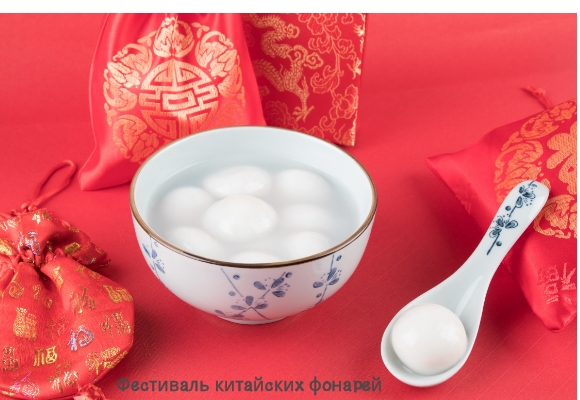
Праздник Юаньсяо или фестиваль фонарей – это красивое завершение китайского Нового года!
Фестиваль фонарей в 2022 г. проходит 15 февраля. Китайцы в этот день лакомятся юаньсяо (круглые пельмешки из рисовой муки), любуются фонарями и отгадывают загадки, написанные на фонарях. Для этого традиционного праздника нет официальных выходных.
Общие данные о фестивале фонарей
· Название праздника на китайском языке: 元宵节 Yuánxiāojié / юаньсяо цзе / «праздник первой ночи»
· Альтернативное китайское название: 上元节 Shàngyuánjié / шан юань цзе / «праздник начала начал»
· Дата: 15-й день первого лунного месяца (19 февраля в 2019 г.)
· Значение: завершение празднования китайского Нового года (праздника Весны)
· Как праздновать? – Любоваться фонарями, отгадывать загадки на фонарях, лакомиться юаньсяо (круглые пельмешки из рисовой муки) в бульоне, танцевать танец льва и дракона и т.д.
· История: около 2000 лет
· Поздравления: Счастливого праздника Юаньсяо! 元宵节快乐!Yuánxiāojié kuàilè! /Юаньсяо цзе кхуай лэ!/
Подробнее о фестивале фонарей
Фестиваль фонарей по традиции завершает празднование самого важного китайского праздника – Нового года по Восточному календарю (праздник Весны). После фестиваля фонарей китайские новогодние запреты больше не действуют, а все новогодние украшения снимаются.
Как известно, китайский Новый год – это время, посвященное семье. Но на 15-й день все, независимо от пола и возраста, выходят на улицы, чтобы отпраздновать фестиваль фонарей. Этот праздник, безусловно, символизирует воссоединение семьи (подробнее об этом чуть позже), но также это время для общения с друзьями и время свободы.
►Дата: Когда проводят фестиваль фонарей?
Фестиваль фонарей отмечают на 15-й день первого лунного месяца. Ниже представлены даты празднования по грегорианскому календарю на ближайшие несколько лет
К сожалению, большинство людей не может быть со своими семьями в этот праздник, так как нет официального выходного дня, а поездки домой не всегда возможны.
Происхождение и история: почему проводится фестиваль фонарей?
Считается, что фестиваль берет своё начало более 2000 лет назад в династии Западная Хань.
В начале правления династии Восточная Хань (25–220 гг.) император Ханьминди придерживался идей буддизма. Он узнал, что некоторые монахи зажигают фонари в храмах на 15-й день первого лунного месяца, чтобы выразить уважение к Будде.
Поэтому он издал указ о том, чтобы во всех храмах, домах и королевских дворцах зажигались фонари в этот вечер.
Этот буддийский обычай постепенно стал важным праздником обычных мирян.
►Традиции и обычаи: Как китайцы отмечают фестиваль фонарей?
За более чем 2000-летнюю историю традиция празднования фестиваля фонарей обогатилась обычаями и мероприятиями, которые привлекают людей разных возрастов, например, любование фонарями и фейерверками, угадывание загадок, написанных на фонарях, исполнение народных танцев и поедание юаньсяо.
1. Зажигание фонарей
Фонари являются наиболее заметными атрибутами праздника, как нетрудно догадаться J
Когда наступает день фестиваля, фонари различных форм и размеров (традиционные шары, рыбы, драконы, козы! – на что только хватит воображения!) можно увидеть повсюду, включая дома, торговые центры, парки и улицы. Всё это многообразие привлекает многочисленных зрителей и туристов. Дети, гуляя по улицам, могут держать в руках маленькие фонарики.
2. Загадки на фонарях (猜灯谜 cāi dēng mí)
Во время фестиваля китайцы записывали загадки на фонарях. Это маленькое развлечение популярно у всех! Оно требует от Вас быть смышленым и нестандартно мыслить.
Фонари украшаются ярким традиционным китайским декором, изображениями и символами, зачастую на фонарях изображают фрукты, цветы, птиц, животных, людей и здания.
Если кто-то знает ответ на загадку, то он может снять фонарь с отгаданной загадкой и пойти к владельцу фонаря, чтобы проверить свой ответ. Если ответ правильный, то можно получить небольшой подарок.
3. Народные танцы: танцы льва и дракона, ходьба на ходулях
Танец дракона существует столько же лет, сколько существует китайская культура. Танцоры создают впечатляющие танцевальные представления под ритм китайских барабанов и бой тарелок.
Танец льва можно увидеть на любом праздничном мероприятии – от праздников и свадеб до открытий магазинов. Замысловатый дизайн львов поражает воображение, у них подвижные глаза и рты. Иногда лев открывает рот и требует еды и красных конвертов с деньгами. Иногда они катаются по земле и играют, как огромные котята.
Хождение на ходулях – это старинное развлечение. Необходимо не просто ходить на ходулях, привязывая их к ногам, но и совершать невероятно сложные движения. Актеры выдают себя за различных персонажей – монахов, клоунов, рыбаков – и выполняют яркие и юмористические номера. Это искусство доставляет удовольствие многим!
4. Лакомство танъюань (юаньсяо)
Важный обычай фестиваля фонарей – поесть танъюань (юаньсяо). 汤圆 tāngyuán / танъюань) также называют юаньсяо, когда их едят во время фестиваля фонарей.
Эти круглые пельмешки изготавливаются из клейкой рисовой муки и наполняются различными начинками, например, белым либо коричневым сахаром, семенами кунжута, арахисом, грецкими орехами, лепестками роз, бобовой либо мармеладной пастой или же комбинацией ингредиентов. Обычно пельмешки юаньсяо сладкие.
Юаньсяо можно сварить, пожарить или приготовить на пару. Их обычно подают в ферментированном рисовом супе, который называется «тяньцзю» (甜酒 tián jiǔ / «сладкий ликер»).
Так как танъюань похоже по произношению на слово «туаньюань» (团圆 / часть целого, часть группы), для китайцев это ассоциируется со счастливым сбором всей семьи. Китайцы считают, что круглая форма шариков и чаш, в которых они подаются, символизирует целостность и единство.
Поэтому угощаться «танъюанем» во время фестиваля фонарей для китайцев означает получить возможность выразить наилучшие пожелания своей семье и пожелать добра в будущем.
Где можно увидеть, как отмечают фестиваль фонарей?
Во время проведения фестиваля фонарей в Китае организуется множество ярмарок, где местные жители и туристы могут своими глазами увидеть и оценить всю красоту, пестроту и многообразие китайских фонарей!
Ниже мы рекомендуем три самых лучших места для празднования и просмотра фонарей и представлений.
· Международный фестиваль фонарей «Цинхуай» (самый масштабный в Китае!) проходит с 29 января по 31 марта 2019 г. в Храме Конфуция в «Qinhuai Scenic Zone» в городе Нанкине.
· Фестиваль фонарей Юйюань в Шанхае проходит с конца января по конец февраля.
· Фестиваль фонарей в парке Юэсю в Гуанчжоу проходит с 25 января по 24 февраля 2019 г. Парк Юэсю в городе Гуанчжоу (вход бесплатный!).
Тур в Китай во время фестиваля фонарей
Фестиваль фонарей завершает празднование китайского Нового года, поэтому многие китайцы отправляются к друзьям и близким, чтобы вместе выйти на улицы и в парки для любования фонарями. Также большое количество людей возвращаются в города на работу и в учебные заведения после продолжительных каникул. В связи с этим могут возникнуть некоторые транспортные трудности – будет сложно приобрести авиа- и ж/д- билеты. Проживание может быть дороже обычного.
Свяжитесь с нами, и мы поможем вам избежать подобных трудностей и сделаем так, чтобы Ваш опыт путешествия в Китай был потрясающим, а фестиваль фонарей стал изюминкой вашей поездки.
Другие интересные статья о Празднике Китая
From Wikipedia, the free encyclopedia
This article is about the Lantern Festival in China. For the Lantern Festival in Korea, see Yeondeunghoe.
This article is about the Lantern Festival in China. For related festivals in the East Asian cultural sphere, see First Full Moon Festival.
| Lantern Festival 元宵節 元宵节 |
|
|---|---|

Lantern Festival celebrated in Tainan at night |
|
| Official name | Yuánxiāo jié (元宵節) / Shàngyuán jié (上元節) |
| Observed by | Chinese |
| Type | Cultural |
| Significance | Marks the end of the Chinese New Year |
| Observances | Flying of paper lanterns; Consumption of tangyuan |
| Date | 15th day of the 1st month (lunisolar year) |
| 2023 date | 5 February |
| 2024 date | 14 February |
| Related to | Chotrul Duchen (in Tibet) Daeboreum (in Korea) Koshōgatsu (in Japan) Magha Puja (in Thailand, Sri Lanka, Myanmar, Cambodia and Laos) Tết Nguyên Tiêu (in Vietnam) |
| Lantern Festival | ||||||||||||||||||||||||||
|---|---|---|---|---|---|---|---|---|---|---|---|---|---|---|---|---|---|---|---|---|---|---|---|---|---|---|
| Traditional Chinese | 元宵節 | |||||||||||||||||||||||||
| Simplified Chinese | 元宵节 | |||||||||||||||||||||||||
| Literal meaning | «Prime Night Festival» | |||||||||||||||||||||||||
|
||||||||||||||||||||||||||
| Hokkien Name | ||||||||||||||||||||||||||
| Traditional Chinese | 十五暝 / 上元 | |||||||||||||||||||||||||
| Literal meaning | «15th Night» / «Top Primary» | |||||||||||||||||||||||||
|
Statues of mother and daughter celebrating the Lantern Festival. Xi’an
The Lantern Festival (traditional Chinese: 元宵節; simplified Chinese: 元宵节; pinyin: Yuánxiāo jié), also called Shangyuan Festival (traditional Chinese: 上元節; simplified Chinese: 上元节; pinyin: Shàngyuán jié), is a Chinese traditional festival celebrated on the fifteenth day of the first month in the lunisolar Chinese calendar, during the full moon. Usually falling in February or early March on the Gregorian calendar, it marks the final day of the traditional Chinese New Year celebrations.[1] As early as the Western Han Dynasty (206 BC–AD 25), it had become a festival with great significance.[2]
During the Lantern Festival, children go out at night carrying paper lanterns and solve riddles on the lanterns (traditional Chinese: 猜燈謎; simplified Chinese: 猜灯谜; pinyin: cāidēngmí).[3][4] In ancient times, the lanterns were fairly simple, and only the emperor and noblemen had large ornate ones.[5] In modern times, lanterns have been embellished with many complex designs.[4] For example, lanterns are now often made in the shape of animals. The lanterns can symbolize the people letting go of their past selves and getting new ones,[6] which they will let go of the next year. The lanterns are almost always red to symbolize good fortune.[7]
The festival acts as an Uposatha day on the Chinese calendar.[8][9] It should not be confused with the Mid-Autumn Festival; which is sometimes also known as the «Lantern Festival» in locations such as Indonesia, Malaysia, and Singapore.[2][10] Lantern Festivals have also become popular in Western countries, such as the Water Lantern Festival held in multiple locations in the United States.[11] In London, the Magical Lantern Festival is held annually.[12]
Origin[edit]
There are several beliefs about the origin of the Lantern Festival. However, its roots trace back more than 2,000 years ago and is popularly linked to the reign of Emperor Ming of the Han dynasty at the time when Buddhism was growing in China.[citation needed] Emperor Ming, an advocate of Buddhism, noticed Buddhist monks would light lanterns in temples on the fifteenth day of the first lunar month. As a result, he ordered all households, temples and the imperial palace to light lanterns on that evening.[13] From there it developed into a folk custom. Another likely origin is the celebration of «the declining darkness of winter» and community’s ability to «move about at night with human-made light,» namely, lanterns. During the Han dynasty, the festival was connected to Ti Yin, the deity of the North Star.[1]
Red lanterns, often seen during the festivities in China
There is one legend that states that it was a time to worship Taiyi, the God of Heaven in ancient times. The belief was that Taiyi controlled the destiny of the human world. He had sixteen dragons at his beck and call and he decided when to inflict drought, storms, famine or pestilence upon human beings. Beginning with Qin Shi Huang, the first emperor of China, all the emperors ordered splendid ceremonies each year. The emperor would ask Taiyi to bring favorable weather and good health to him and his people.[14][5]
Emperor Wu of the Han dynasty directed special attention to this event. In 104 BC, he proclaimed it to be one of the most important celebrations and the ceremony would last throughout the night.
Another legend associates the Lantern Festival with Taoism. Tianguan is the Taoist deity responsible for good fortune. His birthday falls on the fifteenth day of the first lunar month. It is said that Tianguan likes all types of entertainment, so followers prepare various kinds of activities during which they pray for good fortune.[15]
Another legend associates with the Lantern Festival with an ancient warrior named Lan Moon, who led a rebellion against the tyrannical king in ancient China. He was killed in the storming of the city and the successful rebels commemorated the festival in his name.[15]
Yet another common legend dealing with the origins of the Lantern Festival speaks of a beautiful crane that flew down to earth from heaven. After it landed on earth it was hunted and killed by some villagers. This angered the Jade Emperor in heaven because the crane was his favorite. So, he planned a storm of fire to destroy the village on the fifteenth lunar day. The Jade Emperor’s daughter warned the inhabitants of her father’s plan to destroy their village. The village was in turmoil because nobody knew how they could escape their imminent destruction. However, a wise man from another village suggested that every family should hang red lanterns around their houses, set up bonfires on the streets, and explode firecrackers on the fourteenth, fifteenth, and sixteenth lunar days. This would give the village the appearance of being on fire to the Jade Emperor. On the fifteenth lunar day, troops sent down from heaven whose mission was to destroy the village saw that the village was already ablaze, and returned to heaven to report to the Jade Emperor. Satisfied, the Jade Emperor decided not to burn down the village. From that day on, people celebrate the anniversary on the fifteenth lunar day every year by carrying lanterns on the streets and exploding firecrackers and fireworks.[16]
Another legend about the origins of Lantern Festival involves a maid named Yuan-Xiao. In the Han dynasty, Dongfang Shuo was a favorite adviser of the emperor. One winter day, he went to the garden and heard a little girl crying and getting ready to jump into a well to commit suicide. Shuo stopped her and asked why. She said she was Yuan-Xiao, a maid in the emperor’s palace and that she never had a chance to see her family since she started working there. If she could not have the chance to show her filial piety in this life, she would rather die. Shuo promised to find a way to reunite her with her family. Shuo left the palace and set up a fortune-telling stall on the street. Due to his reputation, many people asked for their fortunes to be told but everyone got the same prediction — a calamitous fire on the fifteenth lunar day. The rumor spread quickly.[15]
Everyone was worried about the future so they asked Dongfang Shuo for help. Dongfang Shuo said that on the thirteenth lunar day, the God of Fire would send a fairy in red riding a black horse to burn down the city. When people saw the fairy they should ask for her mercy. On that day, Yuan-Xiao pretended to be the red fairy. When people asked for her help, she said that she had a copy of a decree from the God of Fire that should be taken to the emperor. After she left, people went to the palace to show the emperor the decree which stated that the capital city would burn down on the fifteenth. When the emperor asked Dongfang Shuo for advice, the latter said that the God of Fire liked to eat tangyuan (sweet dumplings). Yuan-Xiao should cook tangyuan on the fifteenth lunar day and the emperor should order every house to prepare tangyuan to worship the God of Fire at the same time. Also, every house in the city should hang red lantern and explode fire crackers. Lastly, everyone in the palace and people outside the city should carry their lanterns on the street to watch the lantern decorations and fireworks. The Jade Emperor would be deceived and everyone would avoid the disastrous fire.[16]
The emperor happily followed the plan. Lanterns were everywhere in the capital city on the night of the fifteenth lunar day and people were walking on the street and there were noisy firecrackers. It looked as if the entire city was on fire. Yuan-Xiao’s parents went into the palace to watch the lantern decorations and were reunited with their daughter. The emperor decreed that people should do the same thing every year. Since Yuan-Xiao cooked the best tangyuan, people called the day Yuan-Xiao Festival.
For each Festival celebrated, a switch in the Chinese Zodiac takes place. If this year is the year of the tiger, next year will be the year of the rabbit(water rabbit) and so on.
Tradition[edit]
Finding love[edit]
In the early days, young people were chaperoned in the streets in hopes of finding love. Matchmakers acted busily in hopes of pairing couples. The brightest lanterns were symbolic of good luck and hope. As time has passed, the festival no longer has such implications in most of Mainland China, Taiwan, or Hong Kong.[10]
Tangyuan or Yuanxiao[edit]
Eaten during the Lantern Festival, tangyuan ‘湯圓’ (Southern China, Taiwan and Southeast Asia) or yuanxiao ‘元宵’ (Northern China) is a glutinous rice ball typically filled with sweet red bean paste, sesame paste, or peanut butter.[3] Actually, tangyuan is different from yuanxiao due to different manual making and filling processes.[17] It can be boiled, fried or steamed, each has independent taste. However, they are very similar in shape and taste, so most people do not distinguish them for convenience and consider them as the same thing.[17] Chinese people believe that the round shape of the balls and the bowls in which they are served symbolize family togetherness, and that eating tangyuan or yuanxiao may bring the family harmony, happiness and luck in the new year.[2][4]
-
Yuanxiao and its fillings
-
Yuanxiao
-
Yuanxiao
-
Yuanxiao
-
Yuanxiao
-
Tangyuan
-
Tangyuan
-
Tangyuan
-
Tangyuan
-
Tang Yuan
6th century and afterwards[edit]
Until the Sui dynasty in the sixth century, Emperor Yang invited envoys from other countries to China to see the colourful lighted lanterns and enjoy the gala performances.[18]
By the beginning of the Tang dynasty in the seventh century, the lantern displays would last three days. The emperor also lifted the curfew, allowing the people to enjoy the festive lanterns day and night. It is not difficult to find Chinese poems which describe this happy scene.[18]
In the Song dynasty, the festival was celebrated for five days and the activities began to spread to many of the big cities in China. Colorful glass and even jade were used to make lanterns, with figures from folk tales painted on the lanterns.[citation needed]
However, the largest Lantern Festival celebration took place in the early part of the 15th century. The festivities continued for ten days. The Yongle Emperor had the downtown area set aside as a center for displaying the lanterns. Even today, there is a place in Beijing called Dengshikou. In Chinese, deng means lantern and shi is market. The area became a market where lanterns were sold during the day. In the evening, the local people would go there to see the beautiful lighted lanterns on display.[citation needed]
Today, the displaying of lanterns is still a major event on the fifteenth day of the first lunar month throughout China. Chengdu in southwest China’s Sichuan Province, for example, holds a lantern fair each year in Culture Park. During the Lantern Festival, the park is a virtual ocean of lanterns. Many new designs attract large numbers of visitors. The most eye-catching lantern is the Dragon Pole. This is a lantern in the shape of a golden dragon, spiraling up a 38-meter-high pole, spewing fireworks from its mouth. Cities such as Hangzhou and Shanghai have adopted electric and neon lanterns, which can often be seen beside their traditional paper or wooden counterparts. Another popular activity at this festival is guessing lantern riddles (which became part of the festival during the Tang dynasty).[19] These often contain messages of good fortune, family reunion, abundant harvest, prosperity and love.[citation needed] Just like the pumpkin carved into jack-o’-lantern for Halloween in the western world, Asian parents sometime teach their children to carve empty the inner tubing of Oriental radish /mooli/ daikon into a Cai-Tou-Lantern (traditional Chinese: 營菜頭燈; simplified Chinese: 营菜头灯; pinyin: yíng cai tóu dēng) for the Festival.[citation needed]
Festivities[edit]
This painting, by an imperial court painter in 1485, depicts the Chenghua Emperor enjoying the festivities with families in the Forbidden City during the traditional Chinese Lantern Festival. It includes acrobatic performances, operas, magic shows and setting off firecrackers.
Lion dance (舞獅), walk on stilts (踩高蹺), riddle games (猜燈謎), dragon dances (耍龍燈) are very popular activities during the festival day and the days following.
The lantern riddle, according to Japanese scholars, became popular as early as the Northern Song Dynasty (960-1126). The lantern riddles are done by a host blocking one side of the lantern and pasting riddles on the remaining three sides of the lanterns. Participants will guess the blocked side by solving the riddles, which is called «breaking/solving lantern riddles». The theme of riddles can be drawn from classics, biographies, poetry, the various philosophers’ well-known stories and novels, proverbs, (the names of) all kinds of birds, animals, and insects, as well as flowers, grasses, vegetables, and herbs. Participants can tear off the riddle of the lantern and let the host verify their answers. Those who answer the correct answer can get a «riddle reward», including ink, paper, writing brushes, ink slabs, fans, perfumed sachets, fruit, or eatables.
[20]
See also[edit]
- Sagichō Fire Festival, the Japanese (Shintoist) festival held in January
- Bon Festival, the Japanese Buddhist Festival held in August
- Festival of Lights (disambiguation), a list of various festivals associated with light
References[edit]
- ^ a b Melton, J. Gordon (2011). «Lantern Festival (China)». In Melton, J. Gordon (ed.). Religious Celebrations: An Encyclopedia of Holidays, Festivals, Solemn Observances, and Spiritual Commemorations. ABC-CLIO. pp. 514–515. ISBN 978-1-5988-4206-7. Retrieved February 15, 2014.
- ^ a b c «Traditional Chinese Festivals: Lantern Festival». Retrieved 14 August 2014.
- ^ a b World Religions at Your Fingertips. Penguin Group. 2009. ISBN 9781592578467.
- ^ a b c Wei, Liming (2011). Chinese Festivals. Cambridge University Press. pp. 25–28. ISBN 978-0-52118-659-9. Retrieved February 15, 2014.
- ^ a b «Lantern Festival». Birmingham Chinese Festival Association. Retrieved April 27, 2019.
- ^ «China HHS». hhscenter.com. HHS News. Retrieved 13 August 2014.
- ^ «Red Lanterns of Prosperity». BBC News. Retrieved 13 August 2014.
- ^ Davis, Edward L. (2009). Encyclopedia of Contemporary Chinese Culture. Taylor & Francis. p. 68. ISBN 9780415777162.
- ^ Artley, Malvin (2014). The Full Moons: Topical Letters In Esoteric Astrology. eBookIt.com. ISBN 9781456622275.
- ^ a b «China Lantern Festival: Customs, Activities, Glutinous Rice Balls». Travelchinaguide.com. 2015-02-14. Retrieved 2015-12-17.
- ^ Festival, Water Lantern. «Water Lantern Festival — Tickets on Sale!». Water Lantern Festival.
- ^ «Magical Lantern Festival». Archived from the original on 2018-09-27. Retrieved 2020-02-23.
- ^ Brown, Ju; Brown, John (2006). China, Japan, Korea: Culture and Customs. ISBN 9781419648939.
- ^ «Origin of Lantern Festival: Legends of Yuan Xiao Festival». Chinatraveldesigner.com. Archived from the original on 2016-03-04. Retrieved 2015-12-17.
- ^ a b c «Archived copy» (PDF). Archived from the original (PDF) on 2014-02-11. Retrieved 2014-08-13.
{{cite web}}: CS1 maint: archived copy as title (link) - ^ a b «元宵节的由来和传说(the Origin of Lantern Festival)». news.xinhuanet.com. Archived from the original on 2015-09-29.
- ^ a b «Do you know the Differences between Yuanxiao and Tangyuan». www.chinaeducationaltours.com. Retrieved 2019-02-24.
- ^ a b Ning, Qiang (2011). Art, Religion, and Politics in Medieval China: The Dunhuang Cave of the Zhai Family. University of Hawaii Press. p. 131. ISBN 9780824827038.
- ^ Richard C. Rudolph, ‘Notes on the Riddle in China’ ,California Folklore Quarterly, 1.1 (Jan. 1942), pp. 65-82 (pp. 75-79).
- ^ Richard C, Rudolph. «Notes on the Riddle in China». California Folklore Quarterly. 1.
External links[edit]
- China’s Festivals Overview
- Lantern Festival
The Lantern Festival (元宵节 or Yuánxiāojié in pinyin) is a Chinese holiday that traditionally marks the end of the Chinese New Year (Spring Festival) celebrations.
Chinese people celebrate this holiday by enjoying colored lantern displays and eating sweet rice balls called tangyuan. Read this article to learn about the history of the Lantern Festival and discover more about how it’s celebrated today.
Table of Contents
- The origins and history of the Lantern Festival
- Origin story one: A Buddhist celebration
- Origin story two: A trick played on the Jade Emperor
- The Lantern Festival through the ages
- The real Chinese Valentine’s Day?
- The Lantern Festival today
- Lantern Festival Activities
- Viewing Lantern displays
- Guessing lantern riddles
- Eating tangyuan
- Watching dragon and lion dances
- Fireworks
- Experience the festivities for yourself!
- Lantern Festival Vocabulary
The origins and history of the Lantern Festival
Today, the Lantern Festival is celebrated on the 15th day of the first month of the Chinese calendar, which generally falls sometime in February or early March. Like many traditional Chinese holidays, the Lantern Festival has a long history.
Lantern Festival celebrations began around 2,000 years ago during the Han Dynasty (202 BCE-220 CE). The holiday’s exact origins are somewhat unclear.
Several different origin stories are used to explain where the festival came from. We’ve outlined two of the most important ones below.
China’s Lantern Festival marks the final day of the 14-day Chinese Spring Festival. It is celebrated on the first full moon of the Chinese New Year.
Origin story one: A Buddhist celebration
One story about the origins of the Lantern Festival says the holiday was created during the time of Emperor Ming of Han (58-75 CE).
At this time, Buddhism was already gaining popularity in China.
Emperor Ming was a supporter of Buddhism and after he learned that it was customary for Buddhist monks to light lanterns on the 15th day of the first lunar month, he decreed that imperial palaces and individual households should do the same. This practice lives on as today’s Lantern Festival.
One Lantern Festival origin story claims that we can find the holiday’s roots in early Chinese Buddhism.
Origin story two: A trick played on the Jade Emperor
Another story used to explain the origins of the Lantern Festival has to do with the Jade Emperor. Supposedly, his favorite crane was killed by some villagers, so he decided to take revenge by burning down their village on the 15th day of the first lunar month.
When his daughter heard about her father’s plan, she felt sorry for the hapless villagers and warned them about what was going to happen.
To save themselves, the villagers decided to trick the Jade Emperor into thinking their village was already on fire. They did this by hanging red lanterns, setting off firecrackers and lighting fires throughout the village.
Their plan worked. The Emperor was deceived and the village was saved. Afterwards, residents continued to light firecrackers and hang red lanterns every year to commemorate the event.
Some say the red lanterns used in today’s Lantern Festival celebrations are meant to represent the firecrackers, lanterns and fires used by ancient villagers to deceive the Jade Emperor.
The Lantern Festival through the ages
Whatever its origins, the Lantern Festival soon developed into a popular Chinese holiday. Thanks to Chinese cultural influence on other Asian countries, it didn’t take long for the festival to spread to neighboring nations like Korea and Japan.
The Lantern Festival has been celebrated with various degrees of pomp and circumstance over the years. In the Tang Dynasty (618-907 CE), lantern festival celebrations lasted for three days.
They were extended to five days during the Song Dynasty (960-1279 CE). In the Ming Dynasty (1368-1644 CE), celebrations were particularly lengthy, with some lasting a full 10 days.
The real Chinese Valentine’s Day?
Although it’s no longer the case today, the Chinese Lantern Festival was closely associated with love in ancient China. So much so, in fact, that some say that it’s the real traditional Chinese Valentine’s Day, a designation usually reserved for describing the Qixi Festival.
In ancient times, there were strict curfews that were meant to keep people inside after dark. Due to traditional gender norms, women were also generally expected to stay indoors at all times, regardless of whether or not there was a curfew in place.
During the Lantern Festival, however, curfews were lifted so people could go out at night to view the lanterns. Women were also allowed to leave the house. Thus, the holiday presented a unique opportunity for people of different genders to mingle with each other.
This romantic facet of the Lantern Festival is reflected in the plot of various Chinese operas, as well as in many works of art and literature from both the Song and Ming Dynasties.
In ancient times, the Lantern Festival was a romantic holiday when people of different genders were allowed to mingle freely.
The Lantern Festival today
Today, the Lantern Festival is still popular, but it isn’t one of the seven official public holidays recognized in Mainland China. Therefore, people in China don’t usually get any days off from school or work for this holiday.
Lantern Festivals have been popular in various Asian countries for hundreds of years. Recently, Chinese-style Lantern Festival celebrations have also started popping up in Western countries, including the United States, where events like the Philadelphia Chinese Lantern Festival enjoy increasing popularity.
Lantern Festival Activities
Nowadays, although love is no longer a main theme, the Lantern Festival is still celebrated with a variety of fun activities.
Viewing Lantern displays
As its name suggests, the most important part of the Lantern Festival revolves around viewing and interacting with grand displays of Chinese lanterns (灯笼 or dēnglóng).
When many people think of Chinese lanterns, they imagine the round, red, basket-ball sized lanterns they may have seen hanging outside Chinese restaurants.
While this type of lantern is certainly omnipresent around the time of Chinese New Year, the lanterns involved in Lantern Festival displays are quite different.
The lanterns used in modern Lantern Festival displays are often quite elaborate.
Instead of being basketball-sized, these lanterns are often enormous, with some of the larger ones measuring over 65 feet (20 meters) high and 330 (100 meters) long.
These giant lanterns aren’t usually round or red. Instead, they’re built into every imaginable color and shape, depicting real and imaginary animals like giraffes and dragons along with giant flowers, trees and palaces.
Groups of lanterns are often arranged together to illustrate famous scenes from various historical or mythological stories.
Lanterns used in lantern displays in the past were made of materials like paper, silk, bamboo, glass or jade and lit with candles from within. Today, the materials used have been updated.
Most are now made with fabric stretched over wire frames and lit with thousands of LED lights.
Iconic floating sky lanterns were often incorporated into Lantern Festival celebrations in the past and flying them was once a favorite activity for children and adults alike. Now, however, they’re considered a fire hazard and have been banned in many places both in China and abroad.
Sky lanterns are beautiful but they also pose a fire hazard.
Guessing lantern riddles
Guessing lantern riddles (猜灯谜 or cāidēngmí) is an activity that dates back at least as far as the Song Dynasty, when scholars wrote riddles on small slips of paper and hung them from lanterns for festival attendees to guess.
Most of these lantern riddles (灯谜 or dēngmí) were simply created as a form of entertainment. Sometimes, however, imperial advisors used them to make suggestions to the emperor.
If the emperor didn’t like a suggestion, the advisors could claim that the riddle had been interpreted incorrectly, thus avoiding his wrath. This was possible because the riddles’ answers were rarely obvious and clear-cut, leaving them open to multiple interpretations.
Guessing lantern riddles is a popular Lantern Festival activity.
Today’s lantern riddles are still open to multiple interpretations and difficult to guess. So difficult, in fact, that they’re referred to as “lantern tigers” (灯虎 or dēnghǔ) and guessing lantern riddles is sometimes referred to as “guessing lantern tigers” (猜灯虎 or cāidēnghǔ, occasionally also written as 打灯虎 or dǎdēnghǔ).
Generally, lantern riddles are based on complex forms of wordplay and may be difficult for even advanced students of Chinese to understand.
Most riddles consist of the riddle itself and a hint that tells the guesser what form he or she should expect the answer to take.
For example, sometimes the hint might indicate that the answer is a Chinese idiom (成语 or chéngyǔ), the name of a country or that it should consist of only one Chinese character.
To get an idea of how difficult these riddles are, check out this list of Chinese-language riddles.
Eating tangyuan
Another popular Lantern Festival activity is eating tangyuan (汤圆 or tāngyuán).
These balls of glutinous rice flour are generally loaded with sweet fillings made from ingredients like black sesame paste. Although most tangyuan are sweet, savory tangyuan do exist.
Most tangyuan are steamed or boiled, but they can also be fried. Usually served floating in a thin hot soup, they’re traditionally white in color.
In recent years, modern versions of tangyuan have also appeared. These come in a mix of bright colors like purple, pink and orange. Creative chefs have updated the fillings, sometimes using less-traditional ingredients like chocolate.
Although they were originally only consumed on festive occasions, nowadays frozen tangyuan can be found in supermarkets throughout the year and can be eaten anytime.
Tangyuan are a popular snack during the Lantern Festival.
The pronunciation of the word tangyuan is similar to that of the word tuanyuan (团圆 or tuányuán), which means “reunion” in Chinese. This, along with the fact that tangyuan are round and are served in round bowls, has led them to become a symbol of family togetherness.
There are some regional variations of this traditional dessert. In southern China, it’s called tangyuan, but in northern China, it’s called yuanxiao (元宵 or yuánxiāo).
Though there are some slight differences in how tangyuan and yuanxiao are prepared and stored, the two are quite similar.
Watching dragon and lion dances
In some parts of China, dragon and lion dances are also performed during the Lantern Festival.
Lion dance (舞狮 or wǔshī) is a type of folk dance typically performed by two dancers wearing a single lion suit. One performer controls the head and front part of the lion’s body, while the other controls the rear.
The performers dance and perform various acrobatic tricks to the beat of drums, gongs and cymbals.
Some lion dances are quite complex and may even include martial arts-inspired moves. In traditional Chinese culture, lions are considered to be powerful, auspicious animals, and lion dances are thought to bring good luck and financial prosperity.
Lion dances are a popular part of Lantern Festival festivities in some parts of China.
Dragon dances (舞龙 or wǔlóng) are usually performed by a large team of dancers. Instead of getting inside a dragon costume, these performers manipulate a long, flexible model of a dragon using poles attached to its body.
Chinese dragons are thought to be powerful, benevolent creatures. Like lion dances, dragon dances are thought to bring good luck to the communities in which they’re performed.
Fireworks
Fireworks (烟火 or yānhuǒ, also called 烟花 or yānhuā) were invented in China, so it should come as no surprise that they’re still an integral part of many Chinese festivals.
Firework displays are popular during the Lantern Festival. In fact, it’s quite common to see and hear fireworks almost every day from the start of the Chinese New Year until the Lantern Festival, which marks the official end of the Spring Festival holiday.
Individuals are prohibited from setting off fireworks in most big cities, so Lantern Festival fireworks displays in urban areas are usually sponsored by local governments.
In rural areas, fireworks and firecrackers (鞭炮 or biānpào) can still be freely bought and set off by individual people, so families may set off their own fireworks on the Lantern Festival just for fun.
Sometimes, fireworks displays are combined with other aspects of the Lantern Festival, such as dragon dancing, which can make for a truly spectacular performance.
Firework displays help add to the festive atmosphere of China’s Lantern Festival.
Experience the festivities for yourself!
If you happen to be in China during the Lantern Festival, make sure to take time to enjoy the celebrations.
Traveling within China during the Spring and Lantern Festivals can be hectic, but most cities will have their own lantern displays. Therefore, you probably won’t need to go far to experience the magic of this holiday.
Even if you aren’t in China, you may still be able to experience the holiday for yourself thanks to the growing popularity of Lantern Festival events in cities around the world.
If you’re interested in finding out more about Chinese holidays and traditions, then check out our articles on some other festivals with a long history like the Chinese Summer Solstice or Teachers’ Day.
If you’re feeling stumped about what to buy your Chinese friends during the holidays, you can also check out our Chinese gift recommendations.
Happy Lantern Festival!
Lantern Festival Vocabulary
| Hànzì | Pīnyīn | Definition |
|---|---|---|
| 元宵节 | Yuánxiāojié | Lantern Festival |
| 元宵节快乐! | Yuánxiāojié kuàilè! | Happy Lantern Festival! |
| 节日 | jiérì | holiday; festival |
| 灯笼 | dēnglóng | lantern |
| 灯谜 | dēngmí | lantern riddle |
| 灯虎 | dēnghǔ | literally «lantern tiger;» another name for a lantern riddle |
| 猜灯谜 | cāidēngmí | guess a lantern riddle |
| 猜灯虎 | cāidēnghǔ | another way to say «guess a lantern riddle» |
| 打灯虎 | dǎdēnghǔ | yet another way to say «guess a lantern riddle» |
| 汤圆 | tāngyuán | glutinous rice balls served in soup |
| 元宵 | yuánxiāo | old name for tangyuan still used in northern China |
| 团圆 | tuányuán | reunite |
| 舞狮 | wǔshī | lion dance |
| 舞龙 | wǔlóng | dragon dance |
| 烟火 | yānhuǒ | fireworks |
| 烟花 | yānhuā | another word for fireworks |
| 鞭炮 | biānpào | firecrackers |
Праздник фонарей (灯节 dēngjié), или, как его чаще называют, юаньсяо 元宵 yuánxiāo, по названию пампушек, которые принято есть в этот день, отмечается в 15-й день первого лунного месяца. Он приходится на первое полнолуние наступившего года и завершает двухнедельное празднование китайского Нового года — Праздника Весны 春节 chūnjié.
Праздник фонарей имеет двухтысячелетнюю историю. Согласно одной из версий, в этот день Вэнь-ди (или Сяовэнь-ди, 孝文帝, 202 – 157 до н. э.) был провозглашен императором, в честь чего повелел украсить дворец красными фонарями. Отсюда пошла традиция любования фонарями. В 104 году до н.э. император У-ди (156 до н. э. — 87 до н. э., правил со 141 года до н. э.) установил Праздник Весны и Праздник фонарей. Специальным императорским указом предписывалось везде развешивать фонари и любоваться ими.
По одной из легенд, в эпоху Хань (206 до н.э. – 220 н.э.), когда буддизм только начал распространяться в Китае, монахи в 15-й день первого лунного месяца зажигали фонари и медититировали перед буддийскими реликвиями.
Начиная с 713 года в Чанъани (ныне Сиань) стали устраивать так называемые «горы фонарей», насчитывающие до 50 и более тысяч экземпляров.
Фонари традиционно изготавливаются из тонкой бумаги, на которой изображали пейзажи, животных, людей. Одними из самых интересных являются «Цзоумадэн» 走马灯 (zǒumǎdēng, букв. «фонарь с двигающейся лошадью»), технология изготовления которых насчитывает более тысячи лет. Свеча внутри фонаря приводит в движение зубчатое колесо, к которому прикреплены фигурки, и на стенках появляются бегущие тени.
Сам праздник продолжается несколько дней. 13-е число первого лунного месяца носит название «День выставления фонарей». В этот день у лавок, торгующих фонарями, выставляются различные модели, чтобы каждый мог себе выбрать по душе. 14-е число – «День проверки фонарей», когда начинают, собственно, зажигать фонари. Кульминация праздника приходится на вечер и ночь 15-го числа, когда повсеместно вспыхивают сотни, тысячи фонарей.
В это время в парках устраивают различные выставки фонарей. В последнее время фонари часто изготавливают в форме знаменитых архитектурных сооружений мира, например, пекинского Храма Неба, московского Храма Василия Блаженного и др. Также в этот день запускают фейерверки, ходят на ходулях, танцуют традиционные танцы, катаются на качелях и др. Широкой популярностью также пользуется отгадывание загадок – текст с загадкой и отгадкой прикрепляется к фонарю, если человек отгадал загадку правильно, то он получает приз.
В этот день также принято есть «юаньсяо» 元宵. Этот обычай известен с эпохи Сун (960-1279). Они изготавливаются из рисовой муки с разнообразной, чаще сладкой начинкой из ягод, фиников, фасоли, масла, шоколада, лепестков роз и др. и затем готовятся на пару или обжариваются в масле. В разных провинциях свои рецепты приготовления юаньсяо. Прежде юаньсяо готовили в каждом доме, теперь, чаще, их покупают в магазинах. Считается, что если в Праздник фонарей всей семьей есть юаньсяо, то семья будет жить дружно и счастливо.
16-17 числа – «Дни догорания фонарей», а 18-е число – «День снятия фонарей». Праздник проходит, но воспоминания о нем остаются на целый год.
© Сайт «Дорогами Срединного Пути», 2009-2023. Копирование и перепечатка любых материалов и фотографий с сайта anashina.com в электронных публикациях и печатных изданиях запрещены.
















